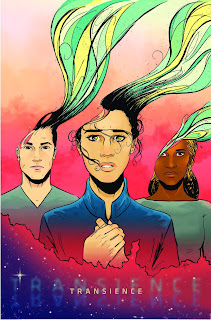Review - Transience
Attacks on the public are nothing new and--sadly--happening more and more often. The consequences are often more physical in nature, but there are definitely more lasting psychological effects as well. In Transience, one such effect is anterograde amnesia. United Kingdom is written by Ricardo Mo and illustrated by Alberto Muriel, United States is written and illustrated by Natash Alterici, Republic of Ireland is written by Sam Read and illustrated by Cian Tormey, Australia is written by Ryan K. Lindsay and illustrated by Mark Lauthier, Italy is written by Kristen Grace and illustrated by Alex Diotto, United States (second) is written by Eric Grissom and illustrated by Will Perkins and Spain is written by Ben Kahn and illustrated by Bruno Hidalgo.
Transience is set in a world where biological attacks have left large swathes of the population with anterograde amnesia - the inability to form new memories past a sleep cycle. The seven stories of Transience look at different people in different parts of the world as they deal with the effects of this at varying numbers of years after the event. There's some hope, some loss and some love. Each story features at least one creator from the country it's set in. So, the Australian story features an Aussie creative team, the Spain story has a Spanish artist and so on.
The premise behind Transience is very fascinating one in its approach of showing the impact of the attack by country and having creators from said country write the stories. This infuses the book with a sense of homegrown familiarity that allows the stories to hit the reader with a bit more emotional heft. Each of the stories looks at different impacted by the attack--for example, Lindsay's story features a man being convinced by his wife that he's a hero on a daily basis. The emotion behind each story is pretty subtle yet effective at hammering home the point that such an attack would have a devastating effect on the day-to-day of world. The overarching thread tying it all together is the shared response to the event; the lack of a more pervasive storyline is what gives it more of an anthology feel.
The artwork throughout Transience is very minimal, but used to maximum effect. Every story is illustrated in a similar, penciled style that allows the emotions of the story to carry the weight as opposed to the artwork. By relying on a simpler style, Transience delivers on the sense of emptiness that comes through the various realizations that the characters are essentially living the same day over and over again. Characters are defined by clean and concise linework set amidst spartan backgrounds in panel layouts that are very formal. And there's really no color throughout the stories as each one is cast in one hue that emphatically sets the stage for the premise of the anthology.
Transience is a fascinating anthology that thrives on both its content and approach. The threat of biological terrorism is very real, but the consequences of the attack here is something very intriguing. The writers all tap into a different response to the attack, yet all of them share in common the fact that no matter what they do things will never be the same. The artwork is very clean and does an excellent job of lending a sense of normality to what is an otherwise unfamiliar situation. Transience is a great read to get a sense of how one global event affects individuals at a more local level.
Transience will be available soon.

Comments
Post a Comment